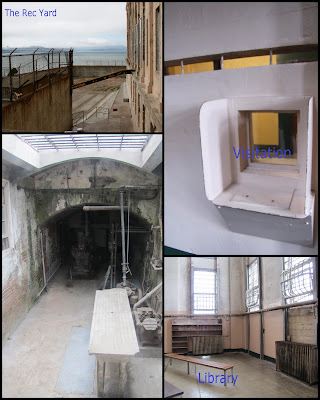After our very tasty lunch we hopped on a MUNI train and rushed to our appointed time for a trip over to ALCATRAZ!
Beautiful views of the city from our boat,
however the bridge seems to always be under a blanket of fog
1.5 miles off the San Francisco coast and referred to as The Rock
The island became a federal prison in 1934. During the 29 years it was in use, the jail held such notable criminals as Al Capone, Robert Franklin Stroud (the Birdman of Alcatraz), George "Machine Gun" Kelly, James "Whitey" Bulger, Bumpy Johnson, Mickey Cohen, Arthur R. "Doc" Barker and Alvin Karpis (who served more time at Alcatraz than any other inmate). It also provided housing for the Bureau of Prison staff and their families.
Sights around The Island
Walking in a free man....
Prison Life
Hard Time
I promise I'll be good!
Paroled
The most violent occurred on May 2-4th in 1946 when a failed escape attempt by six prisoners led to the so-called Battle of Alcatraz. Bernard Coy, a bank robber serving a 25-year sentence at Alcatraz, was in the C Block cell-house sweeping the floor when kitchen orderly Marvin Hubbard called on guard William Miller to let him in as he had just finished cleaning kitchen. As Miller was frisking Hubbard for any stolen articles, Coy assaulted him from behind and the two men overpowered the officer. They then released Joseph Cretzer and Clarence Carnes from their cells.
The cell block had an elevated gun gallery which was regularly patrolled by an armed guard. The guard, Bert Burch, had a set routine and the convicts had attacked Miller while he was away. Coy kept the Springfield rifle in the gallery and lowered a .45 caliber semi-automatic handgun, keys, a number of clubs and gas grenades to his accomplices below. Miller had held on to the yard door key, contrary to the prison's regulations, so that he could let out kitchen staff without having to disturb the gallery guard at lunch. Although they eventually found the key by searching the captive guards and the cell in which the prisoners had placed them, the door would not open because the lock had jammed as the prisoners had tried several other keys while searching for the correct one. The escape attempt was thus inadvertently foiled from the outset as the prisoners were trapped in the cell house.
Meanwhile other guards who entered the cell block as part of their routine were seized along with others sent to investigate when they failed to report in. The prisoners were soon holding nine guards in two separate cells, but with nowhere to go, despair set in among the would-be escapees. At 14:30, Coy took the rifle and fired at the guards in some neighboring watchtowers, wounding one of them. Associate warden Ed Miller went to the cell block to investigate, armed with a gas billy club. He came across Coy who shot at him. Miller retreated. By now the alarm had been raised.
Their plan having failed, Shockley and Thompson urged Cretzer, who had one of the guns, to kill the hostages in case they testified against them. Cretzer opened fire on the guards wounding five, three seriously including Bill Miller who later died of his wounds. Carnes, Shockley and Thompson then returned to their cells, but Coy, Hubbard and Cretzer decided they were not going to surrender.
Unarmed guards undertook the rescue attempt, but they were provided with cover by guards in the two gun galleries overhead. They found their colleagues and sealed off D Block by locking the open door but one guard was wounded by a gunshot from the roof of one of the cell blocks during the rescue. When the last officer had reached safety, a massive gun barrage opened on the prison with D Block subjected to heavy fire from machine-guns, mortars and grenades as the authorities erroneously believed one of the armed convicts was stationed there. Eventually it was established that the mutineers were confined to the main cell house and there was another lull in the battle as tactics were worked out.
Unarmed guards undertook the rescue attempt, but they were provided with cover by guards in the two gun galleries overhead. They found their colleagues and sealed off D Block by locking the open door but one guard was wounded by a gunshot from the roof of one of the cell blocks during the rescue. When the last officer had reached safety, a massive gun barrage opened on the prison with D Block subjected to heavy fire from machine-guns, mortars and grenades as the authorities erroneously believed one of the armed convicts was stationed there. Eventually it was established that the mutineers were confined to the main cell house and there was another lull in the battle as tactics were worked out.
They drilled holes in the prison roof and dropped in grenades into areas where they believed the convicts were in an attempt to force them into a utility corridor where they could be cornered.
On May 3, at about 12:00 noon, the convicts phoned Johnston to try to discuss a deal. Johnston would only accept their surrender. Later that day a shot was fired at a guard as he checked out C Block's utility corridor. That night, a constant fusillade was fired at the cell block until about 21:00. The following morning, squads of armed guards periodically rushed into the cell house firing repeatedly into the narrow corridor. At 09:40 A.M. on May 4, they finally entered the corridor and found the bodies of Cretzer, Coy, and Hubbard.
Alcatraz is a must see if you are ever in San Fran













No comments:
Post a Comment